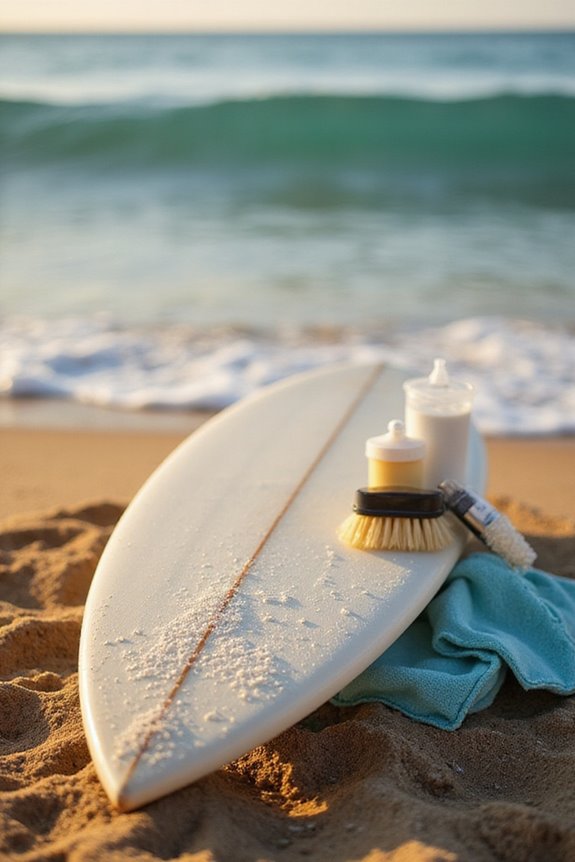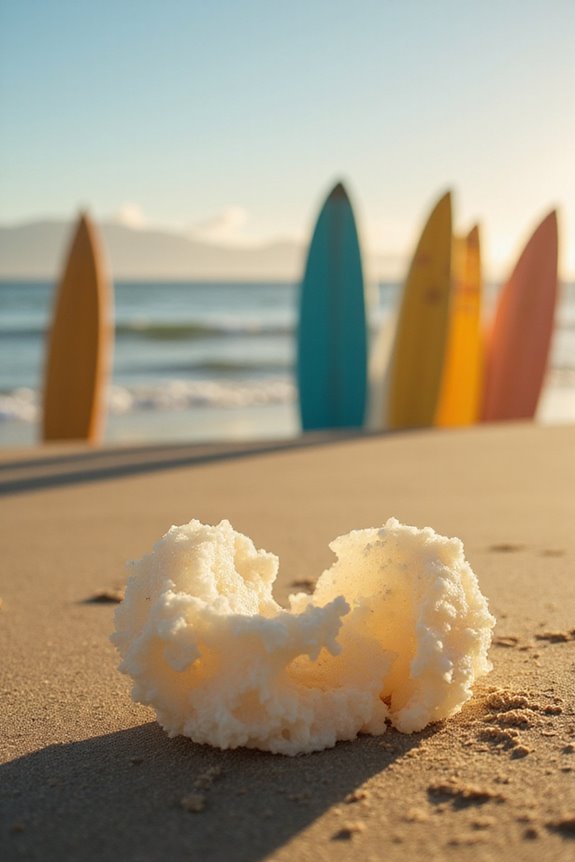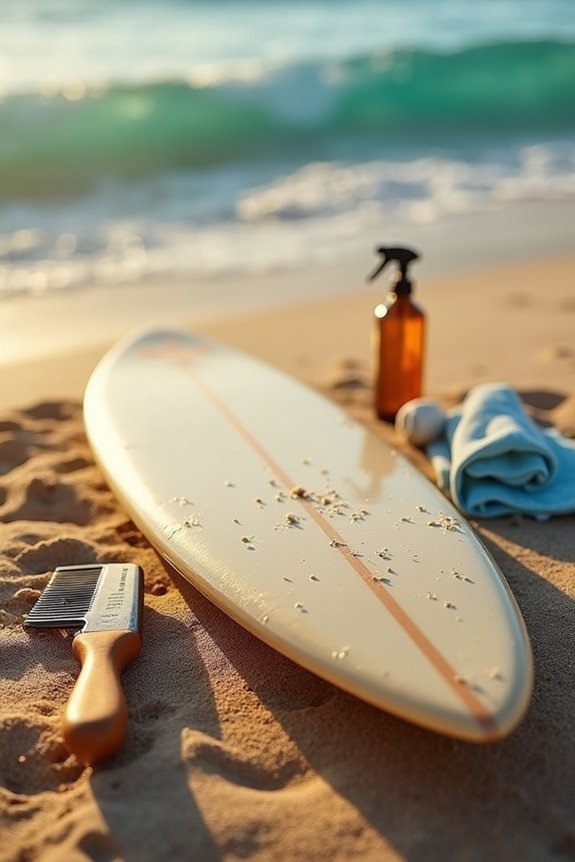To clean our surfboards, we should start with mild dish soap mixed with water for regular maintenance. After each session, rinsing the board with fresh water prevents salt buildup. For wax removal, we can use heat methods or wax scrapers, then apply flour to absorb any residue. Regularly inspect the board for damage and store it in a cool, shaded area. If you want to enhance your cleaning routine, let’s explore more details on techniques and maintenance.
Key Takeaways
- Rinse your surfboard with fresh water immediately after each use to prevent salt buildup.
- Use a mild dish soap mixed with water for deeper cleaning, scrubbing gently with a soft sponge.
- Carefully remove wax using heat methods or a wax scraper, then apply absorptive powder to clean residual wax.
- Store your board in a cool, shaded area and use padded bags to protect it during transport.
- Regularly inspect your board for damages and promptly repair any cracks or dings to maintain its condition.
Types of Cleaning Solutions
When it comes to cleaning our surfboards, selecting the right cleaning solution is essential for maintaining their condition and longevity. For regular maintenance, we can use mild dish soaps like Dawn or Ivory, as they effectively remove dirt without harming the board. Mixing these soaps with water creates a gentle cleaning solution; just remember to rinse thoroughly with fresh water.
Alternatively, vinegar cleaners, made from white vinegar diluted with water, serve as natural disinfectants. They break down grime and salt residue, making them an affordable option. We should test vinegar solutions on a small area first, and always rinse completely to prevent any potential damage. By choosing the right cleaning solution, we can keep our surfboards in top shape, while also considering the environmental impact of our cleaning products.
Wax Removal Techniques
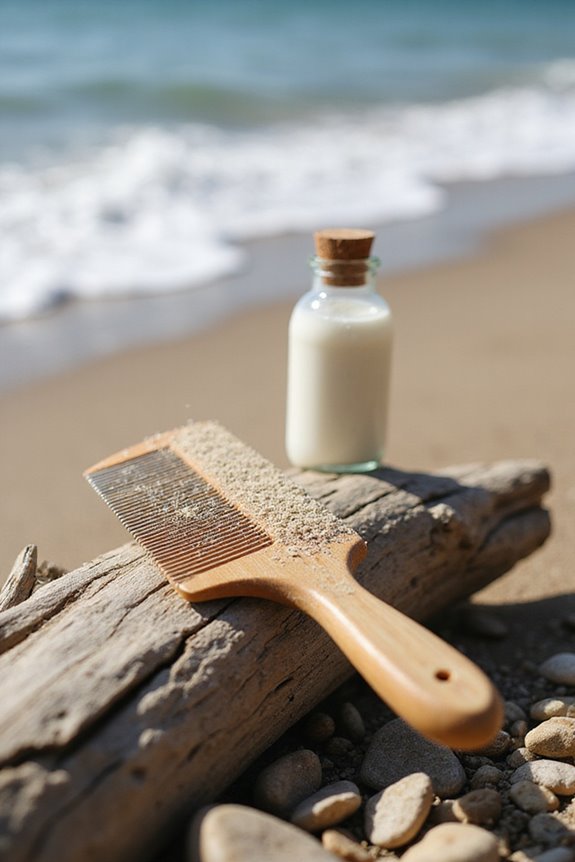
To guarantee our surfboards remain in peak condition, we need effective wax removal techniques to keep their surfaces clean and functional. First, we can use heat-based methods. Leaving our board in direct sunlight for 5 to 15 minutes softens the wax, making it easier to scrape off. Alternatively, we can use a hairdryer on low heat or warm water to achieve the same effect.
Next, for mechanical wax removal, we should utilize a wax scraper or comb. Wax scraping works best when the wax is softened. After scraping, applying absorptive powders like flour can help absorb any residual wax. We sprinkle the powder over the melted wax, let it settle, and then gently wipe it away for a tidy cleaning process. Additionally, choosing oil-based removers can enhance the efficiency of the cleaning process, especially for soft wax.
Routine Cleaning Process
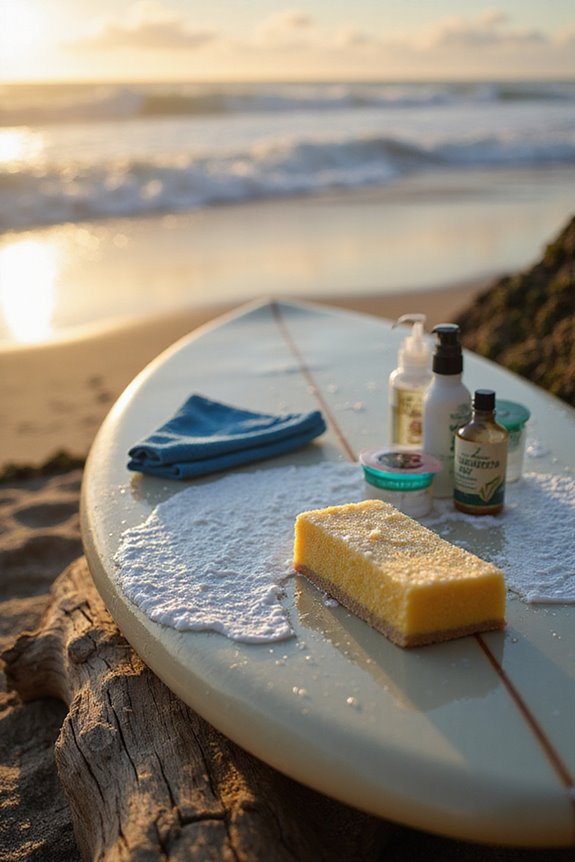
A consistent routine for cleaning our surfboards is crucial for maintaining their performance and longevity. We should start with routine rinsing after every session, using fresh water to remove salt, sand, and debris. Focusing on the deck and rails helps prevent salt crystals from forming, which can cause micro-abrasions.
Next, we can prepare a mild cleaning solution. Using soft sponges or brushes, we’ll employ gentle scrubbing techniques in circular motions to clean areas prone to buildup, like rails and fins. After scrubbing, rinsing again guarantees no soap residue remains. Regular cleaning supports re-waxing, prolonging our board’s lifespan and enhancing its hydrodynamics. By following this routine, we keep our surfboards in top shape for every ride, ensuring that we maintain essential surfing gear for optimal performance.
Maintenance Considerations
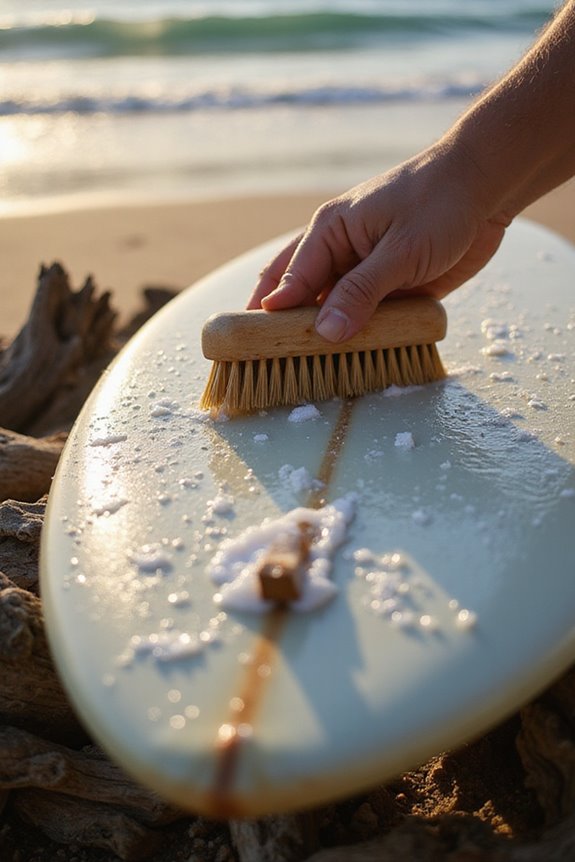
Understanding the importance of proper maintenance can greatly extend the life of our surfboards. Regular cleaning frequency helps keep our boards in top condition. We should store our boards in a cool, shaded area to avoid heat damage and delamination. Using a padded board bag during transport and when not in use protects against dings and UV damage.
Additionally, we must inspect the board regularly for cracks, dings, and signs of delamination. Promptly repairing minor damages prevents further issues. Ensuring our fins are tight and checking for rust helps maintain safety and performance. By taking these maintenance steps, we can enjoy our surfboards for many seasons to come. Using eco-friendly materials in repairs can also minimize environmental impact and ensure safer maintenance practices.
Tools and Materials Recommended
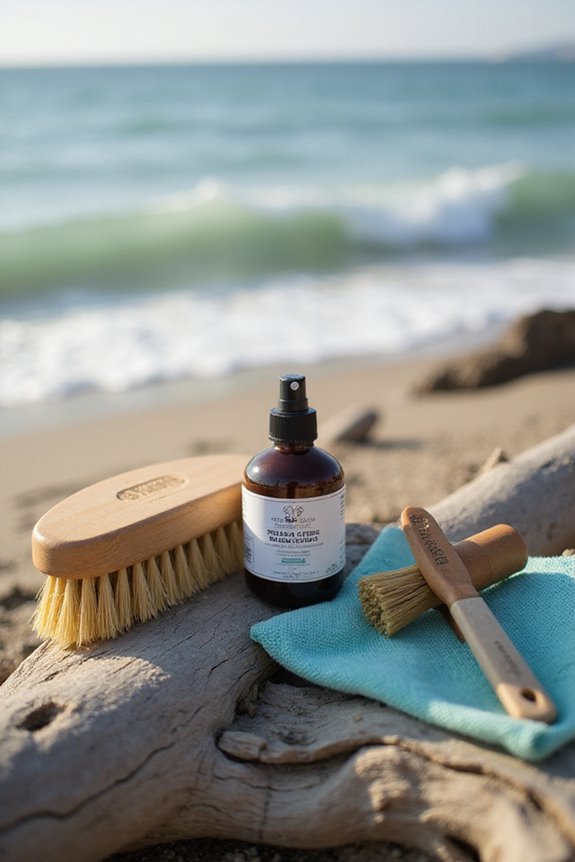
When it comes to cleaning our surfboards, having the right tools and materials is essential for effective maintenance. We should use mild detergents or dedicated surfboard cleaners, avoiding harsh chemicals that can damage the surface. Soft sponges, brushes, and clean microfiber cloths are ideal for scrubbing and drying.
Key Items:
- Cleaning Solutions: Mild, citrus-based detergents mixed with fresh water.
- Cleaning Tools: Soft sponges, brushes for scrubbing, and absorbent towels for drying.
- Wax Removal: Plastic or metal wax combs for effective wax removal.
For best cleaning frequency, we should rinse with freshwater immediately after surfing and store our cleaning supplies in a cool, dry place to maintain their effectiveness. Additionally, regular cleaning helps prevent damage to the surface of the board, ensuring a longer lifespan for our surfboards.
Safety and Precautions
Guaranteeing our safety while cleaning surfboards is essential, as it helps us avoid damage to the board and prevent personal injury. First, let’s focus on handling precautions. We should always place the board on soft, flat surfaces to prevent scratches. Using gentle tools like soft sponges helps avoid harm to the board’s finish.
Next, we need to take into account chemical safety. It’s best to avoid harsh solvents that can degrade the materials. Opt for specialized surfboard cleaners or mild dish soap instead. If we must use stronger chemicals, like acetone, we should apply them sparingly and rinse thoroughly afterward to remove any residues. Additionally, we should also be mindful of UV protection to prevent damage to the board’s surface caused by prolonged exposure to sunlight. By following these precautions, we can guarantee a safe and effective cleaning process.
Tips for Prolonging Board Life
To maximize the lifespan of our surfboards, we need to adopt a consistent maintenance routine alongside safe cleaning practices. Regularly rinsing our boards with freshwater after each session helps remove salt and sand that can cause deterioration. We should also periodically clean off wax buildup and inspect our fins to maintain hydrodynamics.
Storing our boards in a cool, shaded area and using padded bags during transport are essential protective measures. Additionally, we need to watch for dings, cracks, and pressure dents, repairing them promptly to prevent further damage. By taking these steps, we can enhance board longevity and enjoy our surfboards for many seasons to come.
Frequently Asked Questions
Can I Use Bleach to Clean My Surfboard?
While bleach might seem tempting, it’s like pouring acid on a delicate painting. We shouldn’t risk our surfboard materials; instead, let’s explore safer bleach alternatives like mild soap or vinegar to keep our boards pristine.
How Often Should I Wax My Surfboard?
When it comes to waxing frequency, we should reapply after several sessions or when grip diminishes. Regular surfboard maintenance helps us maintain performance, so let’s keep an eye on wax condition for peak traction!
What Is the Best Way to Store My Surfboard?
When it comes to safeguarding our beloved surfboards, we should embrace smart storage techniques. Using surfboard bags helps shield them from the elements, ensuring they stay pristine and ready for our next adventure in the waves.
Can I Clean My Surfboard in the Ocean?
We shouldn’t rely on ocean cleaning for surfboard maintenance. It doesn’t effectively remove salt or grime, and can harm marine ecosystems. Let’s clean our boards properly on land to guarantee they last longer and stay eco-friendly.
How Do I Know if My Surfboard Needs Repairs?
Determining damage demands diligent dents inspection. If we spot cracks or soft spots, prioritizing prompt repairs—like fin replacements—is essential. Let’s guarantee our boards stay strong and surf-ready for those epic wave adventures ahead!

